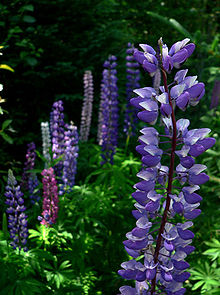
Native plant
Encyclopedia

Indigenous (ecology)
In biogeography, a species is defined as native to a given region or ecosystem if its presence in that region is the result of only natural processes, with no human intervention. Every natural organism has its own natural range of distribution in which it is regarded as native...
) or naturalized
Naturalisation (biology)
In biology, naturalisation is any process by which a non-native organism spreads into the wild and its reproduction is sufficient to maintain its population. Such populations are said to be naturalised....
to a given area in geologic time.
This includes plants that have developed, occur naturally, or existed for many years in an area (e.g. tree
Tree
A tree is a perennial woody plant. It is most often defined as a woody plant that has many secondary branches supported clear of the ground on a single main stem or trunk with clear apical dominance. A minimum height specification at maturity is cited by some authors, varying from 3 m to...
s, flower
Flower
A flower, sometimes known as a bloom or blossom, is the reproductive structure found in flowering plants . The biological function of a flower is to effect reproduction, usually by providing a mechanism for the union of sperm with eggs...
s, grass
Grass
Grasses, or more technically graminoids, are monocotyledonous, usually herbaceous plants with narrow leaves growing from the base. They include the "true grasses", of the Poaceae family, as well as the sedges and the rushes . The true grasses include cereals, bamboo and the grasses of lawns ...
es, and other plants). In North America a plant is often deemed native if it was present before colonization.
Some native plants have adapted to a very limited, unusual environments
Natural environment
The natural environment encompasses all living and non-living things occurring naturally on Earth or some region thereof. It is an environment that encompasses the interaction of all living species....
or very harsh climates or exceptional soil
Soil
Soil is a natural body consisting of layers of mineral constituents of variable thicknesses, which differ from the parent materials in their morphological, physical, chemical, and mineralogical characteristics...
conditions. Although some types of plants for these reasons exist only within a very limited range (endemism), others can live in diverse areas or by adaptation to different surroundings (indigenous plant).
Environmental conditions
Native plants form a part of a cooperative environment, or plant community, where several species or environments have developed to support them. This could be a case where a plant exists because a certain animal pollinatesPollination
Pollination is the process by which pollen is transferred in plants, thereby enabling fertilisation and sexual reproduction. Pollen grains transport the male gametes to where the female gamete are contained within the carpel; in gymnosperms the pollen is directly applied to the ovule itself...
the plant and that animal exists because it relies on the pollen
Pollen
Pollen is a fine to coarse powder containing the microgametophytes of seed plants, which produce the male gametes . Pollen grains have a hard coat that protects the sperm cells during the process of their movement from the stamens to the pistil of flowering plants or from the male cone to the...
as a source of food. Some native plants rely on natural conditions, such as occasional wildfires, to release their seeds
SEEDS
SEEDS is a voluntary organisation registered under the Societies Act of India....
or to provide a fertile environment where their seedlings can become established.
Human intervention
As societies move plants to new locations for cultivation as crops or ornamentals (or transport them by accident), a percentage may become invasive speciesInvasive species
"Invasive species", or invasive exotics, is a nomenclature term and categorization phrase used for flora and fauna, and for specific restoration-preservation processes in native habitats, with several definitions....
, damaging native plant communities in the introduced range. Besides ecological damage, these species can also damage agriculture, infrastructure, and cultural assets. Government agencies and environmental groups are directing increasing resources to addressing these species and their potential interactions with climate change
Climate change
Climate change is a significant and lasting change in the statistical distribution of weather patterns over periods ranging from decades to millions of years. It may be a change in average weather conditions or the distribution of events around that average...
.
Some, however, believe that the introduction of exotic species by humans could be beneficial in the long term if it is done with an intent to blunt the effects of extinction on higher taxa (Theodoropoulos & Calkins, 1990). The rich diversity of unique species across many parts of the world exists only because bioregions are separated by barriers, particularly large river
River
A river is a natural watercourse, usually freshwater, flowing towards an ocean, a lake, a sea, or another river. In a few cases, a river simply flows into the ground or dries up completely before reaching another body of water. Small rivers may also be called by several other names, including...
s, sea
Sea
A sea generally refers to a large body of salt water, but the term is used in other contexts as well. Most commonly, it means a large expanse of saline water connected with an ocean, and is commonly used as a synonym for ocean...
s, oceans, mountain
Mountain
Image:Himalaya_annotated.jpg|thumb|right|The Himalayan mountain range with Mount Everestrect 58 14 160 49 Chomo Lonzorect 200 28 335 52 Makalurect 378 24 566 45 Mount Everestrect 188 581 920 656 Tibetan Plateaurect 250 406 340 427 Rong River...
s and desert
Desert
A desert is a landscape or region that receives an extremely low amount of precipitation, less than enough to support growth of most plants. Most deserts have an average annual precipitation of less than...
s.
Humans, migratory birds, ocean currents, etc. can introduce species that have never met in their evolution
Evolution
Evolution is any change across successive generations in the heritable characteristics of biological populations. Evolutionary processes give rise to diversity at every level of biological organisation, including species, individual organisms and molecules such as DNA and proteins.Life on Earth...
ary history, on varying time scales ranging from days to decades (Long, 1981)(Vermeij, 1991). Humans are moving species across the globe at an unprecedented rate. Those working to address invasive species
Invasive species
"Invasive species", or invasive exotics, is a nomenclature term and categorization phrase used for flora and fauna, and for specific restoration-preservation processes in native habitats, with several definitions....
view this as an increased risk. Theodoropoulos (2003) disagrees, believing that anthropogenic (human-assisted) dispersal can in no way be distinguished from natural dispersal, and in fact, this "increased rate of anthropogenic dispersal is a natural corollary of increased anthropogenic disturbance, and is not a harmful process, but a beneficial mitigation."
Native plant movement
Native plant activists support the introduction of ecological concepts and practices by gardeners, especially in public spaces. The identification of local plant communities provides a basis for their work.See also
- AdaptationAdaptationAn adaptation in biology is a trait with a current functional role in the life history of an organism that is maintained and evolved by means of natural selection. An adaptation refers to both the current state of being adapted and to the dynamic evolutionary process that leads to the adaptation....
- BiocoenosisBiocoenosisA biocoenosis , coined by Karl Möbius in 1877, describes the interacting organisms living together in a habitat . This term is rarely used in English, as this concept has not been popularized in Anglophone countries...
- BiodiversityBiodiversityBiodiversity is the degree of variation of life forms within a given ecosystem, biome, or an entire planet. Biodiversity is a measure of the health of ecosystems. Biodiversity is in part a function of climate. In terrestrial habitats, tropical regions are typically rich whereas polar regions...
- California native plantsCalifornia native plantsCalifornia native plants are plants that existed in California prior to the arrival of European explorers and colonists in the late 18th century...
(examples) - Community ecology
- EcosystemEcosystemAn ecosystem is a biological environment consisting of all the organisms living in a particular area, as well as all the nonliving , physical components of the environment with which the organisms interact, such as air, soil, water and sunlight....
- Exotic plants
- FloraFloraFlora is the plant life occurring in a particular region or time, generally the naturally occurring or indigenous—native plant life. The corresponding term for animals is fauna.-Etymology:...
- Genetic evolution
- GardeningGardeningGardening is the practice of growing and cultivating plants. Ornamental plants are normally grown for their flowers, foliage, or overall appearance; useful plants are grown for consumption , for their dyes, or for medicinal or cosmetic use...
- HabitatHabitat* Habitat , a place where a species lives and grows*Human habitat, a place where humans live, work or play** Space habitat, a space station intended as a permanent settlement...
- Introduced speciesIntroduced speciesAn introduced species — or neozoon, alien, exotic, non-indigenous, or non-native species, or simply an introduction, is a species living outside its indigenous or native distributional range, and has arrived in an ecosystem or plant community by human activity, either deliberate or accidental...
- Landscape ecologyLandscape ecologyLandscape ecology is the science of studying and improving relationships between urban development and ecological processes in the environment and particular ecosystems...
Native Plant Societies
- Natural environmentNatural environmentThe natural environment encompasses all living and non-living things occurring naturally on Earth or some region thereof. It is an environment that encompasses the interaction of all living species....
- Natural landscapingNatural landscaping.Natural landscaping, also called native gardening, is the use of native plants, including trees, shrubs, groundcover, and grasses which are indigenous to the geographic area of the garden.-Maintenance:...
- NatureNatureNature, in the broadest sense, is equivalent to the natural world, physical world, or material world. "Nature" refers to the phenomena of the physical world, and also to life in general...
- Plant community
- Restoration ecologyRestoration ecology-Definition:Restoration ecology is the scientific study and practice of renewing and restoring degraded, damaged, or destroyed ecosystems and habitats in the environment by active human intervention and action, within a short time frame...
- SpeciationSpeciationSpeciation is the evolutionary process by which new biological species arise. The biologist Orator F. Cook seems to have been the first to coin the term 'speciation' for the splitting of lineages or 'cladogenesis,' as opposed to 'anagenesis' or 'phyletic evolution' occurring within lineages...
- Sustainable agricultureSustainable agricultureSustainable agriculture is the practice of farming using principles of ecology, the study of relationships between organisms and their environment...

